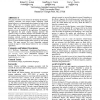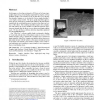49 search results - page 5 / 10 » Preserving the mental map in interactive graph interfaces |
86
Voted
IUI
2003
ACM
15 years 4 months ago
2003
ACM
This paper describes lessons learned in developing the linguistic, cognitive, emotional, and gestural models underlying virtual human behavior in a training application designed t...
126
Voted
SI3D
2003
ACM
15 years 4 months ago
2003
ACM
In this paper we develop an interactive 3D browser for large topographic maps using a visual display augmented by a haptic, or force feedback, display. The extreme size of our dat...
114
Voted
HCI
2007
15 years 1 months ago
2007
User interface (UI) plasticity denotes UI adaptation to the context of use (user, platform, physical and social environment) while preserving usability. Our approach to this proble...
CHI
2005
ACM
16 years 19 hour ago
2005
ACM
The development of programming skills is a motivating issue in computer science. Programming languages have been increasingly used to map end-users needs and mental models. The nu...
CHI
2009
ACM
16 years 6 days ago
2009
ACM
Multi-touch interactions are a promising means of control for interactive tabletops. However, a lack of precision and tactile feedback makes multi-touch controls a poor fit for ta...



